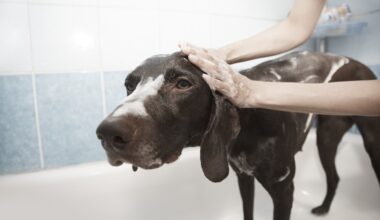Choosing Toys for Senior Dogs with Vision or Hearing Loss
Selecting the right toys for senior dogs that experience vision or hearing loss is critical for their happiness and engagement. As dogs age, they may face challenges in both sight and sound, which can affect their playtime enjoyment. When considering the best toys, comfort and safety must come first. Look for toys made from soft materials to prevent any potential injuries. Additionally, choosing safe and sturdy toys ensures your pet’s well-being during play. Consider the shape of the toys as well; dogs with limited vision might benefit from toys that are brightly colored or have unique textures to enhance tactile feedback. Interactive toys can also be great, as they stimulate their minds without relying heavily on sight or sound. You might even want to look for toys that emit scents or have different textures to keep seniors engaged. Finding the right balance between engagement and safety will enable your older dog to enjoy their toys, which is crucial as they navigate through their golden years. Always supervise playtime and regularly inspect toys for wear and tear, ensuring your dogs have a safe and enjoyable experience.
Using sound to aid play is essential. Toys that produce noise, such as squeaky toys, can grab the attention of senior dogs who may have some hearing left but struggle with faint sounds. Additionally, the use of textures is equally important; toys with varied surfaces can catch their interest and keep them active. Consider toys that are soft but durable, allowing for easy handling without risk of injury. A few examples of great choices include plush toys that are safe for their teeth and harder rubber toys that can withstand chewing. Interactive puzzles make for an excellent choice, providing mental stimulation without relying solely on their hearing or vision. You might also explore toys designed with weighted features that can encourage your dog to engage through pawing and nudging, which can be especially beneficial for those with diminished abilities. Furthermore, a toy box specifically designated for them can help senior dogs feel more in control since they can choose which toys to play with. Remember, understanding your dog’s individual needs and preferences will help you build a fantastic toy collection tailored just for them.
Textured Toy Options
Textured toys can significantly enhance the play experience for senior dogs losing sight or hearing ability. These toys usually come in various shapes and materials that are not only engaging but also help stimulate your dog’s remaining senses. Many dogs genuinely enjoy toys made of rubber, plush, or natural fibers, which can produce different sensations while they chew or gnaw on them. The good news is that you can find toys designed specifically for older dogs, tailored to their needs and physical limitations. When you think texture and shape, consider toys like chew bones or fuzzy balls with raised bumps to offer tactile feedback. Some toys even have crinkly materials inside that provide a fun sound experience for those who can still partially hear. Keeping the senior dog’s preferences in mind can help facilitate a fun play environment. Searching for textures that mimic their favored materials can entice them to play longer and engage thoroughly. Little adjustments in toy design make significant differences, allowing senior dogs to connect, have fun, and feel fulfilled during their playtime.
Furthermore, consider incorporating scent-based toys into their collection. Scent plays a crucial role in the lives of dogs, especially those facing visual and auditory challenges. Toys infused with different scents can stimulate your senior dog’s curiosity and encourage them to explore. For example, look for toys with natural scents such as those infused with essential oils that are safe for dogs or toys containing herbs that may interest them. Interactive scent games, like hiding treats in specific compartments within a toy, also provide a wonderful way to engage their sense of smell. Another option could include toys that release treats with a gentle nudge; these enhance their interaction while promoting mental stimulation. Always ensure that any scent-related toy you choose is safe, non-toxic, and age-appropriate. Regularly rotating their toys can also keep them fresh and exciting. Scent-based toys offer an enriching experience that encourages play without reliance on sight or sound, ensuring your senior dog remains mentally active and fulfilled, enhancing their overall well-being in this stage of life.
Choosing Safe Materials
When selecting toys for your senior dog, prioritize safety by examining the materials used. Many commercial toys may contain harmful chemicals or materials not suitable for older dogs. Opt for toys specifically labeled as non-toxic, durable, and designed for senior pets. Pay attention to the texture of the material and its suitability for vulnerable teeth or sensitive gums. Soft rubber toys, for example, are better suited than hard plastic options that might chip or break. Furthermore, avoid toys with small parts or embellishments that could pose choking hazards. In addition, consider the size of the toys; too small a toy might lead to choking, while oversized toys may be challenging for them to handle. Always observe your dog during playtime to ensure they are engaging safely and comfortably with their toys. Investing in higher-quality options made from safer materials may prevent injuries and accidents, thus prolonging their joy and engagement. By being mindful of materials chosen, you can guarantee that playtime remains safe, enjoyable, and tailored well to meet your senior dog’s needs.
You can further enhance your senior dog’s playtime by integrating technology into their toy selection. Tech-enhanced toys often incorporate features that automate movement, sound, or light. These innovations can intrigue senior dogs struggling with limited senses. For example, toys that move autonomously may capture their attention, enticing them to join in playful pursuits. Look for options that activate when touched, encouraging your pet to interact without solely relying on hearing or sight abilities. However, be cautious about the complexities involved; you will want to ensure that control features are easy for your senior dog to manage. Battery-operated toys with soft designs can also be enticing. Always test these toys yourself, ensuring they meet durability standards and won’t pose risks if any electronic parts malfunction. Involving tech in your dog’s play allows for increased engagement, bridging the gap that age may create between them and traditional playtime experiences. Ultimately, these toys can be excellent choices to rejuvenate play with a blend of old-style fun and modern entertainment.
Conclusion and Tips for Successful Play
In conclusion, choosing toys for senior dogs with vision or hearing loss necessitates a focus on their unique needs and preferences. Prioritize safety and comfort, focusing on materials, texture, sound, and scent. Always be adaptable and willing to explore various types of toys while prioritizing their safety during playtime. A mixture of textured toys, safe materials, and tech-based options can create a well-rounded selection that keeps them interested. Observe how your dog interacts with different toys to understand their specific preferences. Engaging with your pet during play can help strengthen their bonds, offering them the companionship they need, especially as they age. It’s amazing how simple interactions surrounding toys can bring them joy and fulfillment. Regularly rotating their toys helps prevent boredom and keeps the excitement alive, providing them a stimulating environment. Finally, always supervise your dog during playtime to ensure safety and prevent any potential accidents. With patience, experimentation, and attention to detail, you can create an enriching play atmosphere that contributes positively to your senior dog’s quality of life.


